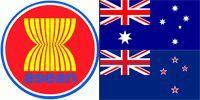
Six months after negotiations on the deal were concluded, the free trade agreement (FTA) between Australia, New Zealand and the Association of South East Asian Nations (ASEAN) was signed in Thailand on Friday, proclaimed as a central element of the region’s action on the global recession.
The ASEAN, Australia and New Zealand Free Trade Agreement (AANZFTA) was signed by trade ministers from the 12 countries in Hua Hin, south of Bangkok, and was described as comprehensive in its scope.
The 10 nations of the ASEAN group – Indonesia, Malaysia, Philippines, Singapore, Thailand, Brunei, Vietnam, Laos, Burma (Myanmar) and Cambodia – represent a market of over 500m people.
Trade between ASEAN and Australia is already worth A$80bn (US$51bn), according to the country’s trade minister Simon Crean, and trade with New Zealand was worth NZ$4.6bn (US$2.3bn) in 2008, said trade minister Tim Groser.
In a joint statement, the ministers said the agreement had come “at a time of widespread concern about the global economy and world economic growth.”
The statement also said the signatories “regard the AANZFTA Agreement as an integral part of the region’s response to the global financial crisis.”
While horticulture didn’t get top billing in the agreement, the sector is still expected to derive significant benefits from the FTA.
Tariffs on New Zealand apples and kiwifruit to some markets will be phased out by 2010, and within 12 years 99 per cent of tariffs will be cut out on exports to the key markets of Malaysia, Indonesia, the Philippines and Vietnam, reported the New Zealand Herald.
Going the other way, 85 per cent of ASEAN imports to New Zealand will be tariff-free by next year, and the remaining 15 per cent will be totally phased out by 2020.
Across the Tasman, Australia’s National Farmers Federation (NFF) said tariffs under 5 per cent would give the country’s producers the confidence to keep building trade relationships, reported the ABC.
“That’s particularly important at the moment because we’ve seen countries around the world trying to pull down the shutters on their markets and close their borders under the guise of the global financial crisis,” said NFF spokesman Ben Fargher.
“So to lock in access into such a growth market, particularly in the current economic climate, is positive.”
All Vietnamese tariffs on Australian imports will be cut to zero between 2016 and 2020, down from current levels as high as 40 per cent.
Most Australian exports will see tariffs cut to zero from next year to 2015. Potatoes will go from a 25 per cent to 18.75 per cent tariff in Indonesia in 2025, and 40 per cent to 32 per cent in the Philippines in 2020.
Several lines of Australian vegetables bound for Indonesia or the Philippines will keep tariffs of 5-10 per cent, but otherwise all lines will be phased to zero tariffs, Neil Barker of exporter BGP International told Fruitnet.
“The big disaster, however, is that mandarins to Indonesia stay at a prohibitive 25 per cent until 2025. Indonesia is a main market for Australian mandarins,” he said.
Of particular interest is the agreement’s sanitary and phytosanitary (SPS) dispute-settlement mechanism, giving such contests an option outside the lengthy, expensive World Trade Organisation (WTO) mediation system.
The new system may be used by Philippine banana, mango and pineapple exporters to address Australian access complaints, reported the Business Mirror.
A dispute on the decade-long access restriction had not been brought before the WTO because of the prohibitive cost and arduous litigation required, according to Philippine foreign affairs undersecretary for international economic concerns Edsel Custodio.
AANZFTA is expected to come into force in late 2009, according to Australia’s Department of Foreign Affairs and Trade, following the domestic ratification of Australia, New Zealand and at least four ASEAN countries. It will come into force no later than 1 January 2010.



